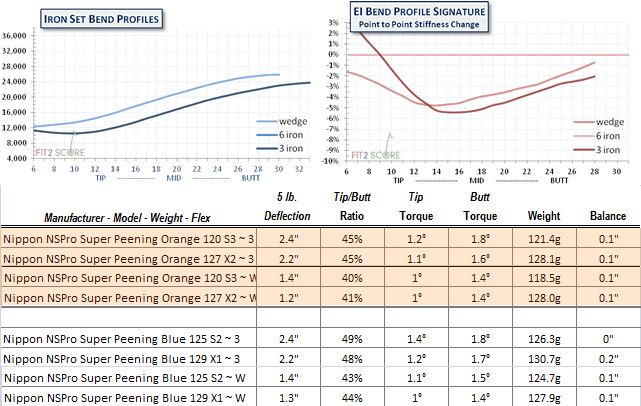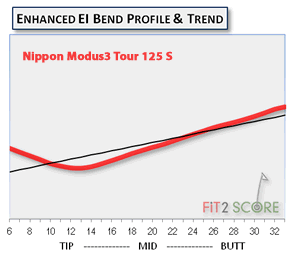Nippon N.S.Pro Super Peening
By Russ Ryden, A Golf Digest America’s 100 Best Clubfitter
Fit2Score, Dallas Fort Worth, Texas
I am in the process of rebuilding the Fit2Score shaft knowledge base with 3 iron and wedge profiles. Nippon sent a box full of review samples including the N.S.Pro Super Peening Orange and Blue. I had briefly looked at the Super Peening Blue wedge shafts in the past. They had been suggested as a wedge addition to my fitting system. Readers have asked several times about these shaft so I was interested in getting a full set of measurements of these samples.
The N.S.Pro Super Peening shafts are no longer shown the the Nippon brochures. I had to find a 2008 catalog to see how Nippon presented the shafts. The descriptions there were brief, and the terms used to describe the shafts Orange = Mid Kick Point and Blue = Butt Kick Point brought me back to a time when I was taught to think about shafts with those terms. We were taught back then that the higher the kick point the lower the shaft would launch. My exploration of EI profiles vastly expanded my understanding of a golf shaft beyond things like kick point and frequency matching. As I looked at the measurement of these two shafts I realized they are good examples to discuss the nature of 3 point EI profiles.
 The ‘mid kick’ Orange has a steeper EI curve than the ‘butt kick’ Blue. This is how one can see the launch propensity of a shaft by simply looking at the EI curve. Also, the Tip to Butt ratio indicates launch. The Blue, lower launching design has a higher number, the tip stiffness is a larger percentage of the butt stiffness. That means there is less change of stiffness between the butt and tip of the shaft. The smaller the change, the lower the launch propensity of the shaft.
The ‘mid kick’ Orange has a steeper EI curve than the ‘butt kick’ Blue. This is how one can see the launch propensity of a shaft by simply looking at the EI curve. Also, the Tip to Butt ratio indicates launch. The Blue, lower launching design has a higher number, the tip stiffness is a larger percentage of the butt stiffness. That means there is less change of stiffness between the butt and tip of the shaft. The smaller the change, the lower the launch propensity of the shaft.
Look at the Profile Signatures, there is a greater loss of stiffness in the ‘mid kick’, higher launching Orange than the ‘high kick’, lower launching Blue.
EI curves are a refined view of launch propensity. Look again at the profile signatures. The 3 iron shafts lose more stiffness near the tips than the wedge shafts from the set. A fitter that knows the profiles of the shafts he works can quickly make fitting decisions based on his knowledge of the shafts. He has a fundamental understanding of the shafts he is presenting during your fitting. As you read iron shaft reviews here in the future, set profiles will be discussed.
Most sets are ‘flighted’ to some degree. The shorter irons are not just stiffer, they are often designed, either intentionally or as a byproduct of material or structure, to, in legacy terminology, have ‘higher kick points’. And as a result, a propensity to launch the ball lower.
As I transition the iron shaft section of the Fit2Score software from a simple view of comparing 6 irons to the expanded view of sets I asked myself why iron sets had not always been presented this way to the club building community. It was through my involvement with PCS that I first encountered the concept of shaft profiling using frequency instruments. As I asked myself the question, why 6 irons and not sets, I answered it. The frequency system with a 454g tip weight could not measure tip stiffness commonly seen in the short end of the golf shaft iron sets. This was quickly confirmed by one of our editors, John Dranschak earlier today. As instrumentation and technology evolve, the systems we use to understand golf gear do likewise. Understanding iron shafts by looking only at 6i shaft profiles is better than not knowing anything about shaft bend profiles. But the expanded view of looking also at the long and short end of the sets is an essential tool in iron set fitting.

As I measured these shafts I compared them to the Modus3 product line. I just published a review of the new Modus3 Tour 125. I quickly realized ihe Modus3 Tour 125 is so similar to the Super Peening Blue, it is hard to tell them apart. While they are both designated 125g shafts, the new metallurgy used in the Modus3 shafts resulted in the same shaft about 5 grams lighter. All else is virtually identical. If you played the Super Peening Blue in the past, you should be accustomed to the feel and performance of the new Modus3 Tour 125.
